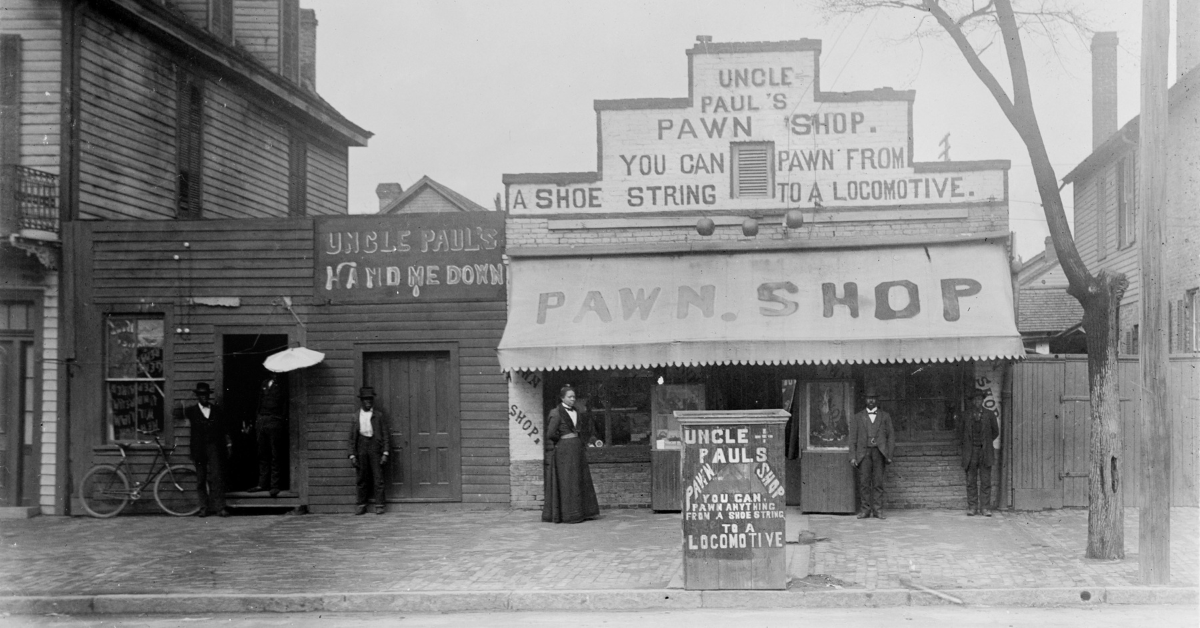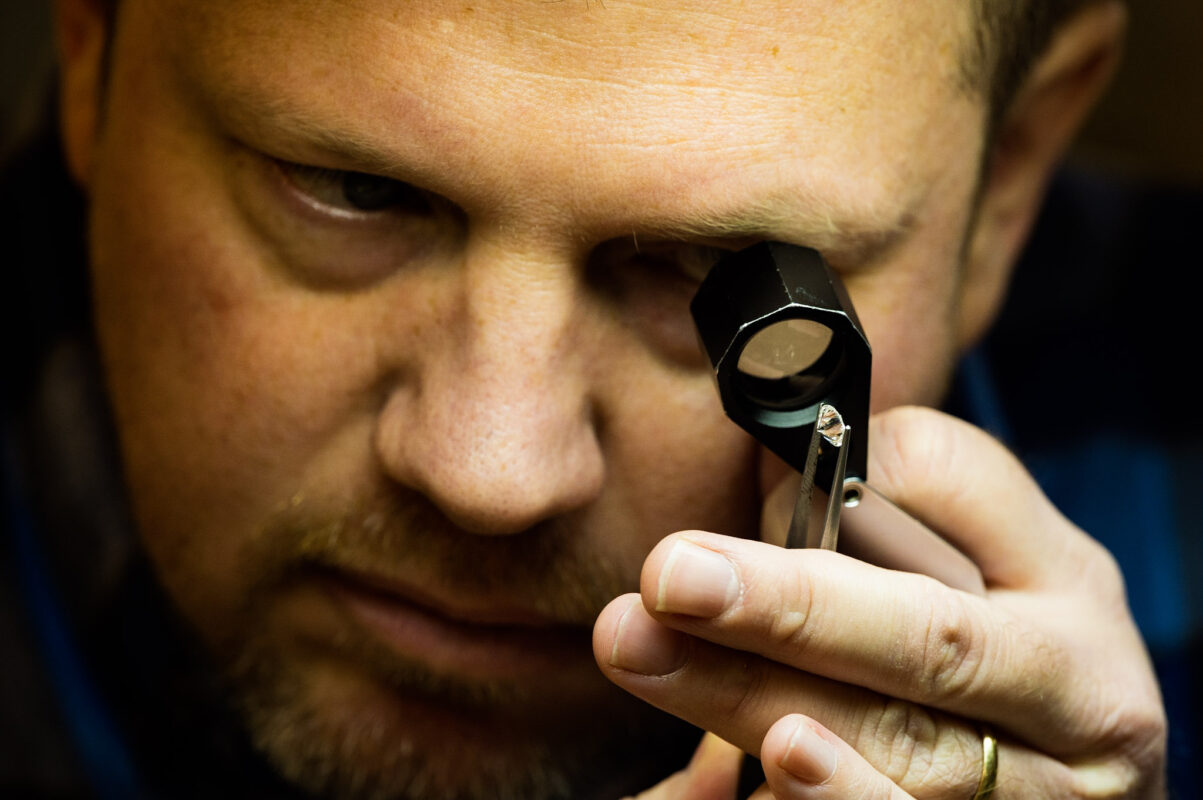When you first think of pawning jewelry or pawn shops, you may think of the TV show “Pawn Stars,” or maybe even a Quentin Tarantino film. However, pawn shops aren’t just an American practice, although more than 30 million Americans use pawn shops yearly. The practice of pawning has been around for centuries, dating back to ancient China. Today, it’s a $14.5 billion industry with 11,000+ pawnbrokers across the U.S. While pawning jewelry or other valuables might seem like a great way to get quick cash, educating yourself on the industry, the process, and its setbacks is essential. Here are some reasons why avoiding pawn shops might be in your best interest and some alternative options to get cash for your jewelry. What Are Pawn Shops, And How Do They Work? A pawn shop (also called a pawnbroker) is a business that loans money to people who bring in valuable items, which they then leave with the pawn shop. The valuables left behind are known as “collateral,” meaning security for the loan provided by the pawn shop. The person can get their valuable item(s) back from the pawn shop if they pay back the money the pawn shop loaned them with interest. However, suppose the person doesn’t repay the loan and interest within an agreed-upon timeline. In that case, the pawnbroker can sell the valuable item to another customer to get back the money the pawn shop loaned. How Do Pawn Shops Make Money? Pawn shops make money in two ways: (1) making personal loans and (2) selling unclaimed collateral items. Providing Personal Loans Pawn shops give out personal loans to individuals who relinquish custody of an item, such as jewelry or electronics. The amount a pawn shop is willing to lend is based on a few different factors: the value of the item, the pawnshop’s inventory at the time of the loan, and demand for the item. Since individuals seeking a pawn loan typically can’t qualify for a traditional bank loan, the risk of default is higher. That’s why pawn shops make loans with substantially higher interest rates than banks typically charge for personal loans. State law governs the amount of interest a pawn shop is allowed to charge. In Texas, the maximum pawn shop rate is 240% APR! That’s high! Reselling Pawn shops’ second primary income source is retail sales on unclaimed merchandise and items purchased outright from individuals. How Much Will Pawn Shops Give For Your Jewelry? If you are considering pawning jewelry, you might wonder how much pawn shops offer. Unfortunately, selling your jewelry to pawn shops guarantees the lowest amount of money in exchange for your items, thanks to the business model we outlined above. While pawn shops tend to offer more money to purchase items outright than to lend against them, it still will only get you about 50% of the value of your jewelry. Even if you need cash in a pinch, there are more lucrative ways to sell and get more out of the value of your jewelry. Alternatives to Pawning Jewelry If you want more money out of your jewelry, there are better ways! It also makes sense to outright sell jewelry you no longer want or need, rather than taking out a loan with a pawn shop. Those interest rates are no joke, especially in Texas! Here are some other, more lucrative, ways to sell your jewelry: Selling Online While this isn’t a great option if you need cash on the spot, you can sell your jewelry online to get more value out of your jewels. eBay is a great, safe option for everyday sellers. If you end up needing to do an in-person transaction, here are some do’s and don’ts to ensure your safety: DON’T agree to meet strangers alone. DON’T give out your address. DO meet in a safe, public place. DO accept cash only. Dallas Gold & Silver Exchange We’ve been around since the 1960s. We’ve stood the test of time by offering customers the most for their jewelry and being a trustworthy source of information. If you don’t believe us, shop around before you come to see us! We’ll give you the best offer and the best experience with our friendly, knowledgeable associates. You can bring your jewelry to any of our metroplex locations during our business hours at your convenience. No appointment is necessary. Want to learn more about the selling process at Dallas Gold & Silver Exchange? Let Loreina walk you through the easy process by clicking the video below!
Category Archives: Silver
Humans have spent thousands of years entranced by gemstones and precious metals. In some ways, we’re like fish – we’re attracted to shiny things! That’s why jewelry and gemology are such fascinating subjects with rich histories. It’s also why it’s so difficult to tell the real deal from the imitation. While costume jewelry and diamond alternatives are beautiful accessories, they won’t get you the cash that a *real* piece of jewelry will. Here are our tips to distinguish the real jewelry from the fake… and how to know when to seek a professional’s opinion. Precious Metals While we see today’s Olympic champions bite their gold medals, we don’t suggest this course of action for actually testing whether or not your gold is real. The history of the “gold bite test” dates back to merchants who would trade gold coins for goods. If their bite left teeth marks, the coin was deemed a fake since forgers would alloy their gold coins with other metals, including lead. In fact, some Olympians have even chipped their tooth whilst chomping down on their hard-earned medals! So, please (please) don’t do this. There’s a much easier (and dentist-approved) way to test the validity of the precious metals in your jewelry: look for stamps. Jewelry will often have teeny-tiny marks stamped on them in order to indicate their metals and fineness. We suggest getting our your readers for this. Here are some popular marks and what they mean: Metal US Fineness Marks International Fineness Marks 9- or 10-karat gold 9K or 10K 375 (37.5% pure gold) or 417 (41.7% pure gold) 14-karat gold 14K 585 (58.5% pure gold) 18-karat gold 18K 750 (75.0% pure gold) 24-karat gold 24K 999 (99.9% pure gold) Platinum PT 950 Sterling Silver 925 or sterling 925 Some jewelry pieces are unmarked, or the mark might be damaged. In this case, you can always bring the piece into one of our locations for a free check – no appointment is needed. Diamonds vs. Diamond Alternatives While metals have markings that can help the average consumer distinguish the real from the imitation, diamonds are a little trickier. An untrained eye can typically spot a real diamond, however there are a few diamond simulants that can dupe jewelry enthusiasts: Cubic Zirconia (or CZ) If you’ve ever shopped for an engagement or wedding ring at a big box store, you might know that CZ is used to simulate a diamond to visualize what it would look like in a certain setting. There are a few key differences to distinguish CZ from a real diamond. First, the dispersion of a CZ is much higher than that of a diamond. This means that the CZ will break up the light into a larger spectrum of colors than a diamond will. Second, most CZs are completely colorless. This is rare in real diamonds – a colorless diamond falls into the D color category on the diamond color scale. Even really stunning diamonds will have a twinge of yellow, while you won’t typically see this in CZs. Synthetic Moissanite This is a relatively newer diamond alternative that has recently gained popularity. Similar to the CZ, it also has more dispersion than that of a natural diamond. Natural moissanite is so rare, that if you’re looking at moissanite in jewelry, odds are that it’s synthetic. According to Brilliant Earth, “The most effective way to tell moissanite apart from a diamond is to use a loupe to look through the top, or the crown, of the jewel at an angle. You will see two slightly blurred lines that indicates a double refraction, an inherent quality of moissanite.” White Sapphire or White Topaz Unlike the previous alternative, white sapphire and white topaz will have less dispersion than a natural diamond. Glass Glass is more transparent than diamond. Another easy way to tell the difference is to check for inclusions Most diamonds will have inclusions that can either be seen with the naked eye or with a jeweler’s loupe. Glass will not have any inclusions as it will be hand-cut to simulate a diamond. Lab-Grown Diamonds You might be asking, “what about lab-grown diamonds?” Well, lab-grown diamonds technically are diamonds. However, since they’re man-made and manufacturing is ever-growing, they don’t fetch the same prices as natural diamonds since they are easier to come by. In fact, it’s often speculated that the value of these man-made alternatives will go down rather than up like their natural counterparts. Lab-grown diamonds can fool cheap diamond testers, so if you’re wondering whether or not yours was grown in a lab we recommend bringing it in for a closer look. Emeralds, Sapphires, and Other Gemstones There aren’t really any great DIY tests for gemstones, so the simple answer to this is just to bring it in to one of our GIA Graduate Gemologists. They’ll easily be able to distinguish real gemstones from imitations. While we don’t typically purchase pearls, there is a DIY method to check if they’re real or not. While we don’t encourage using your teeth to test gold, it is okay to use your teeth to test pearls. Simply rub the pearl against your teeth! If it feels grainy, you’ve got a genuine pearl on your hands. If it feels smooth, odds are that it’s not real. Other Tips to Distinguish Real Jewelry From The Fake We always recommend bringing in an item for our experts to take a look at, especially if you wish to sell it. Whether you sell it to us or not is up to you – and we’ll look at it for free, so there’s nothing to lose. You can visit us at any of our DFW locations in Dallas, Euless, Frisco, Grand Prairie, Grapevine, and Lewisville – no appointment needed.
Maybe you have some sterling silverware lying around. Maybe it’s in your attic or a dark corner of your dining room. Whether it’s been in your family for generation, or it was a stray wedding gift, it’s hard to take care of. It needs to be polished every 6 weeks or so, and 3 weeks before you plan on using it for a dinner party (although there aren’t many of those these days given the COVID-19 pandemic). So, you decide to sell your silver. It’s not worth the upkeep and you could use the cash. For most, selling sterling silverware isn’t a common occurrence. It’s easy to feel overwhelmed by the many places that claim to give the best offers for silver. That’s why we created a guide to selling sterling silverware where we answer many of the frequently asked questions we get from sellers. We want you to feel confident selling your silver — even if you don’t sell with us! Sterling Silver or Silver-Plated? Whether or not your silverware is sterling silver or silver-plated makes a big difference. The easiest way to tell is to look for the hallmarks stamped into your items. If your silverware is silver-plated, it’s best to keep it, donate it or try your luck online. The resale value isn’t very high on these items, and sometimes the hassle isn’t worth it. Try looking on eBay or other resale sites for similar sets and designs to decide on your pricing. If your silverware is sterling silver, this makes it much easier to sell. That’s because it can be melted down to make something new or re-sold for a good price in a retail store. To determine the rough worth of your sterling silverware, you can do a little research. Then, you can bring it to Dallas Gold & Silver for a free, no-pressure offer from our experts. How Much is My Sterling Silver Flatware Worth? Basically, the price of any silver is always going to be tied to the market price of silver. Check the current market price of silver before you sell your silverware to get an idea of the current silver price. Weigh your silverware and convert that weight into troy ounces to get a better idea of its value. Avoid Selling Sterling Silverware in Pawn Shops In pawn shop shows, it seems like they have all the answers for any item you bring in. This is rarely the case. Pawn shops buy (or pawn) a lot of items, which means they can be jacks of all trades, but masters of none. Dallas Gold & Silver Exchange knows silver – it’s in our name, after all! And we’re NOT a pawn shop. Our experts have been dealing with precious metals for decades — pawn shops have got nothing on them. Compare Prices and Shop Around You want to ensure you’re getting the best price — we get it! That’s why we encourage you to shop around. We’re confident that we’ll be able to give you the best price in DFW. Our experts are ready to take a look at your items and give a free, no-pressure offer Monday-Saturday. Visit us in Dallas, Euless, Grand Prairie, Grapevine and Lewisville!



